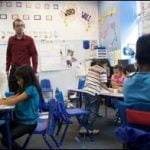
A new study by Pew Research Center shows the disparity of education levels among religious groups. Jews rank as the faith group with the most formal education, with Christians in second place, while Muslims and Hindus have the least years of formal schooling.
WASHINGTON – A new study showing the disparity of education levels among religious groups ranks Jews as the faith group with the most formal education and Muslims and Hindus with the least years of formal schooling.
Christians are the second-highest educated religious group in the world, followed by the religiously unaffiliated and Buddhists, according to the global demographic study by the Pew Research Center, released December 13.
The report also showed differences in educational levels among religious groups in the same region. In sub-Saharan Africa, Christians tend to have higher average levels of education than Muslims – in part because of historical factors that include the work of missionaries.
The study’s findings do not match the U.S. picture where Muslims and Hindus are often better educated than the Christian majority. Ninety-six percent of Hindus and 54 percent of Muslims in the U.S. have college degrees, compared to 36 percent of Christians.
The gaps in education in religious groups around the world are partly the result of where these groups live. For example, the majority of the world’s Jews live in the United States and Israel – economically developed countries with high levels of education – while 98 percent of Hindu adults live in developing countries of India, Nepal and Bangladesh.
The report, using census and survey data from 151 countries, also found large gender gaps in educational levels within some major world religions.
Muslim women around the world average 4.9 years of education, compared with 6.4 years among Muslim men which is similar to Hindu women, who average 4.2 years of education, compared with 6.9 years among Hindu men.
The vast majority, 91 percent, of Christian adults ages 25 and older have had some formal education, and one in five has a post-secondary degree. In recent years, gender differences in educational levels among Christians have narrowed, particularly since equal numbers of Christian men and women have had a post-secondary education.
Among younger Christians, more women than men are likely to have received higher education. And in some countries, Christian men have experienced declines in post-secondary education in recent generations.
The data varies by region. Globally, Christians have spent an average of 9.3 years in school. This average ranges from six years of education in sub-Saharan Africa to 12.7 years of schooling in North America.
Also, the gender gap for Christian education is nonexistent in North America and Latin America but in sub-Saharan Africa, Christian women have 1.8 fewer years of schooling, on average, than Christian men.
On the good news front, the report showed that many of the disparities in educational levels seem to be decreasing. Muslims and Hindus, the religions with the lowest levels of education, have made the biggest educational gains in recent generations.
Researchers also found that gender gaps also are slightly narrowing. Among older members of religious groups, the men received more years of education than women. But the youngest generations of Christian, Buddhist and religiously unaffiliated women are on par educationally with the men their age.
Among young Jewish adults, Jewish women have spent nearly one more year in school, on average, than Jewish men. Jews on average have had 13.4 years of schooling, the report points out.
One takeaway from the study is that even with recent gains by young adults, education around the world lags for many people. The global norm is barely more than a primary education – an average of about eight years of formal schooling for men and seven years for women.
At the high end of the spectrum, 14 percent of adults ages 25 and older have a university degree or other kind of higher education, such as advanced vocational training. An even larger percentage – 19 percent of adults worldwide, or more than 680 million people – have no formal schooling at all.
[Source:-Crux]



